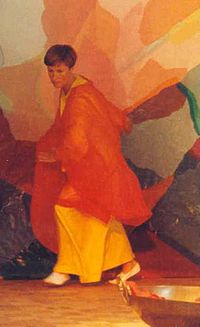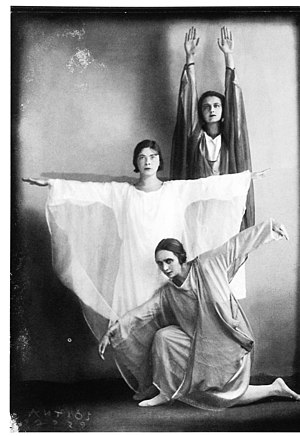Eurythmy


Eurythmy (from the Greek: εὖ eu "beautiful, good" and ῥυθμὀς rhythmos "harmonically ordered movement"; note that the word eurythmy is spelled only with "r" and not with "rh") is an art of movement practised professionally by eurythmists. After the first beginnings in 1908, it was developed between 1912 and 1924 by Rudolf Steiner and Lory Maier-Smits. It is learned at various institutes in a professional training of several years. In Germany, there has been an official, internationally accredited academic chair for eurythmy at the Alanus University since 2006.
Fundamentals
Eurythmy is not a dance art in the usual sense. There are no arbitrary or conventional elements in it, but it makes visible externally through the movement of the body what lives as objective inner etheric and spiritual movement in speech and music. When the human being speaks or sings, these movements physically live out only in the larynx and the adjacent organs of speech and song; eurythmy metamorphoses these into the living movement of the whole human body in space. A distinction can be made between speech eurythmy and tone eurythmy. Later, light eurythmy was developed as a supplement for stage art. Purely artistic eurythmy is joined by pedagogical eurythmy and curative eurythmy as further special disciplines. Pedagogical eurythmy, as practised in Waldorf schools, promotes the harmonious development of the growing human being. Therapeutic eurythmy supports the healing process by harmonising the inner organic activity through the eurythmically ordered body movement.
Development of Eurythmy
The foundation of eurythmy dates back to the early 20th century. The first indications of Rudolf Steiner's preoccupation with the art of movement go back to 1908, when he gave twelve lectures on the Gospel of John from 18 to 31 May. After the first lecture on the beginning of the Gospel of John, Steiner is said to have approached the Russian painter and writer Margarita Woloschin with the question of whether she could dance these passages. At least that is what Voloshin reports in her autobiography "The Green Serpent". Her answer was: "I think you can dance everything you feel", to which Steiner is supposed to have said: "But it's the feeling that counts today. Here Steiner's idea of an anthroposophical art of dance and movement is condensed for the first time, which was to lead to the development of eurythmy in the years to come.
According to tradition, Lory Maier-Smits was given her first eurythmy task in mid-December 1911 in Berlin, when her mother Clara Smits had a conversation with Steiner in which he asked about her daughter's professional intentions. According to Steiner's instructions, she was to stride alliterations, taking a strong, somewhat stamping step on the alliterative bar parts and a pleasing arm movement on the bar parts without consonants. Not only striding forward, but also striding backwards just as energetically. Lory Maier-Smits became the first eurythmist and eurythmy teacher.
The name "Eurythmy" was suggested by Steiner's wife Marie von Sievers. This happened in the last lesson of the first eurythmy course held for Lory Smits in Bottmingen from 16 to 27 September 1912. In terms of dance history, the emergence of eurythmy can be seen in the context of the revolutionisation of dance theatre and body consciousness at the beginning of the twentieth century.
From the point of view of its inventor, eurythmy is the art of making laws and relationships that are effective in language and music visible through human movement. For this purpose, various creative means are used, such as gestures, colours and spatial forms (choreography). The movement is created out of the awareness of the relationship between the body and the surrounding space and time. The eurythmic shaping of a piece of music or poetry is intended to make visible its artistic form and the formative forces that produce it.
According to eurythmists, the origin of gestures and movements lies in the spatial and temporal fields of force that the human form produces and in which the human being moves. The eurythmist tries to make the connections inherent in language or music and working in them visible with gestures and movements through synchronous formation in space, according to anthroposophical ideas.
Stage eurythmy
In eurythmy performances, dramatic, epic and lyrical, but also humorous works of language and music poetry of all epochs are presented as "inspired visible language" and "visible song", both in large choreographic group productions and in soloistic form. The performers are dressed in colourful robes (and usually also with veils), the stage design is usually restrained and works mainly with coloured light effects. In terms of dance history, the emergence of eurythmy can be seen in the context of the revolutionisation of dance theatre and body awareness at the beginning of the twentieth century.
According to Steiner followers, the origin of gestures and movements lies in the spatial and temporal fields of force that produce the human form and in which the human being moves. Speaking, making music and mental activity also follow the laws of space and time as movements. The eurythmist tries to make visible in space not his own state of mind, but the connections inherent in language (and in tone eurythmy, in music) and working in it, by means of gestures and movements through synchronous formation. Gestures, forms and body positions were developed on the methodological basis of Rudolf Steiner's "Philosophy of Freedom" with the help of the anthroposophical spiritual science elaborated by him and on the epistemological basis of the holistic way of research inaugurated by Johann Wolfgang von Goethe.
Literature
- Cynthia Hoven, Renée Parks (Illustrator): Eurythmy Movements and Meditations: A Journey to the Heart of Language. HeartSong Press 2012. ISBN 978-0615631585
- Barbara Tapfer, Matthew Barton (Translator): An Illustrated Guide to Everyday Eurythmy: Discover Balance and Self-Healing through Movement. Floris Books 2017. ISBN 978-1782503736
- Werner Barfod, Virginia Sease (Preface), Sally Lake-edwards (Translator): Zodiac Gestures in Eurythmy. Floris Books 2019. ISBN 978-1782505679
- Adrian Anderson: The Lost Zodiac of Rudolf Steiner: Exploring the four sets of zodiac images designed by Rudolf Steiner. Threshold Publishing 2016. ISBN 978-0994160256
- Gertraud Goodwin (Editor): Zodiac: An Exploration into the Language of Form, Gesture and Colour. Temple Lodge Publishing 2019. ISBN 978-1912230396
- Rudolf Steiner, A. Stott (Translator): Eurythmy, Its Birth and Development. CW 277a. Rudolf Steiner Press 2019. ISBN 978-1855845664
- Rudolf Steiner, A. Stott (Translator): Eurythmy as Visible Singing. CW 278. 8 lectures, Dornach, Feb. 19-27 1924. Rudolf Steiner Press 2019. ISBN 978-1855845671 rsarchive.org
- Rudolf Steiner, Alan Stott (translator): Eurythmy as Visible Speech. CW 279. Rudolf Steiner Press 2019. ISBN 978-1855845688 rsarchive.org
German
- Eurythmie - Aufbruch oder Ende einer jungen Kunst?, Flensburger Hefte Nr. 73, Flensburger Hefte Vlg., Flensburg 2001
- Sivan Karnieli: Wer sich bewegt, kommt zu sich selbst. Eurythmie für jeden Tag, Futurum Vlg., Basel 2013
- Andrea Heidekorn: Eurythmie - mit der Zeit gehen und gegen den Strom schwimmen. In: Manon Haccius/Götz E. Rehn (Hg.): Anthroposophische Perspektiven, DUMONT-Vlg., Köln 2012, S. 42 - 55
- Annemarie Dubach-Donath: Die Grundelemente der Eurythmie. Verlag am Goetheanum, Dornach 1928 6. Auflage 1988, ISBN 3-7235-0028-5.
- Lory Maier-Smits: Erste Lebenskeime der Eurythmie (aus Aufsätzen von 1951). In: Erinnerungen an Rudolf Steiner. Freies Geistesleben, Stuttgart 1979; 2. erw. Auflage 2001, ISBN 3-7725-1979-2.
- Magdalene Siegloch: Lory Maier-Smits. Die erste Eurythmistin und die Anfänge der Eurythmie. Verlag am Goetheanum (Pioniere der Anthroposophie 12), Dornach 1993, ISBN 3-7235-0689-5.
- Magdalene Siegloch: Eurythmie. Eine Einführung. Freies Geistesleben, Stuttgart 1990; Neuausgabe (als Taschenbuch) 1997, ISBN 3-7725-1237-2.
- Rüdiger Grimm (Hrsg.): Heilende Kräfte in der Bewegung. Die Anwendung der Heileurythmie in der Heilpädagogik. Freies Geistesleben, Stuttgart 1997, ISBN 3-7725-1589-4.
- Arfst Wagner (Hrsg.): Eurythmie. Aufbruch oder Ende einer jungen Kunst? Flensburger Hefte (FH 73), Flensburg 2001, ISBN 3-935679-01-7.
- Michael Brater u. a.: Betriebseurythmie. Ein Übungsweg zu Teambildung und beweglicher Arbeitsorganisation. Freies Geistesleben, Stuttgart 2002, ISBN 3-7725-1109-0.
- Beatrix Hachtel, Angelika Gäch: Bibliographie Heileurythmie. Veröffentlichungen 1920–2005. Natur Mensch Medizin, Bad Boll 2007, ISBN 3-928914-16-2.
- Eva Froböse (Hrsg.): Rudolf Steiner über Eurythmische Kunst. DuMont Buchverlag, Köln 1983, ISBN 3-7701-1527-9.
- Sylvia Bardt: Eurythmie als menschenbildende Kraft. Freies Geistesleben, Stuttgart 1998, ISBN 3-7725-0276-8.
- Tatjana Kisseleff: Eurythmie-Arbeit mit Rudolf Steiner.Verlag Die Pforte, Basel 1982, ISBN 3-85636-062-X.
- Gilbert Prilasnig: Der Zusammenhang von Sprache und Bewegung: Fokus: Heileurythmie, AV Akademikerverlag 2015, ISBN 978-3639844733
- Rudolf Steiner: Entsprechungen zwischen Mikrokosmos und Makrokosmos, GA 201 (1987), ISBN 3-7274-2012-X English: rsarchive.org German: pdf pdf(2) html mobi epub archive.org
- Rudolf Steiner: Eurythmie als sichtbare Sprache , GA 279 (1990), ISBN 3-7274-2790-6 English: rsarchive.org German: pdf pdf(2) html mobi epub archive.org
 |
References to the work of Rudolf Steiner follow Rudolf Steiner's Collected Works (CW or GA), Rudolf Steiner Verlag, Dornach/Switzerland, unless otherwise stated.
Email: verlag@steinerverlag.com URL: www.steinerverlag.com. Index to the Complete Works of Rudolf Steiner - Aelzina Books A complete list by Volume Number and a full list of known English translations you may also find at Rudolf Steiner's Collected Works Rudolf Steiner Archive - The largest online collection of Rudolf Steiner's books, lectures and articles in English. Rudolf Steiner Audio - Recorded and Read by Dale Brunsvold steinerbooks.org - Anthroposophic Press Inc. (USA) Rudolf Steiner Handbook - Christian Karl's proven standard work for orientation in Rudolf Steiner's Collected Works for free download as PDF. |
